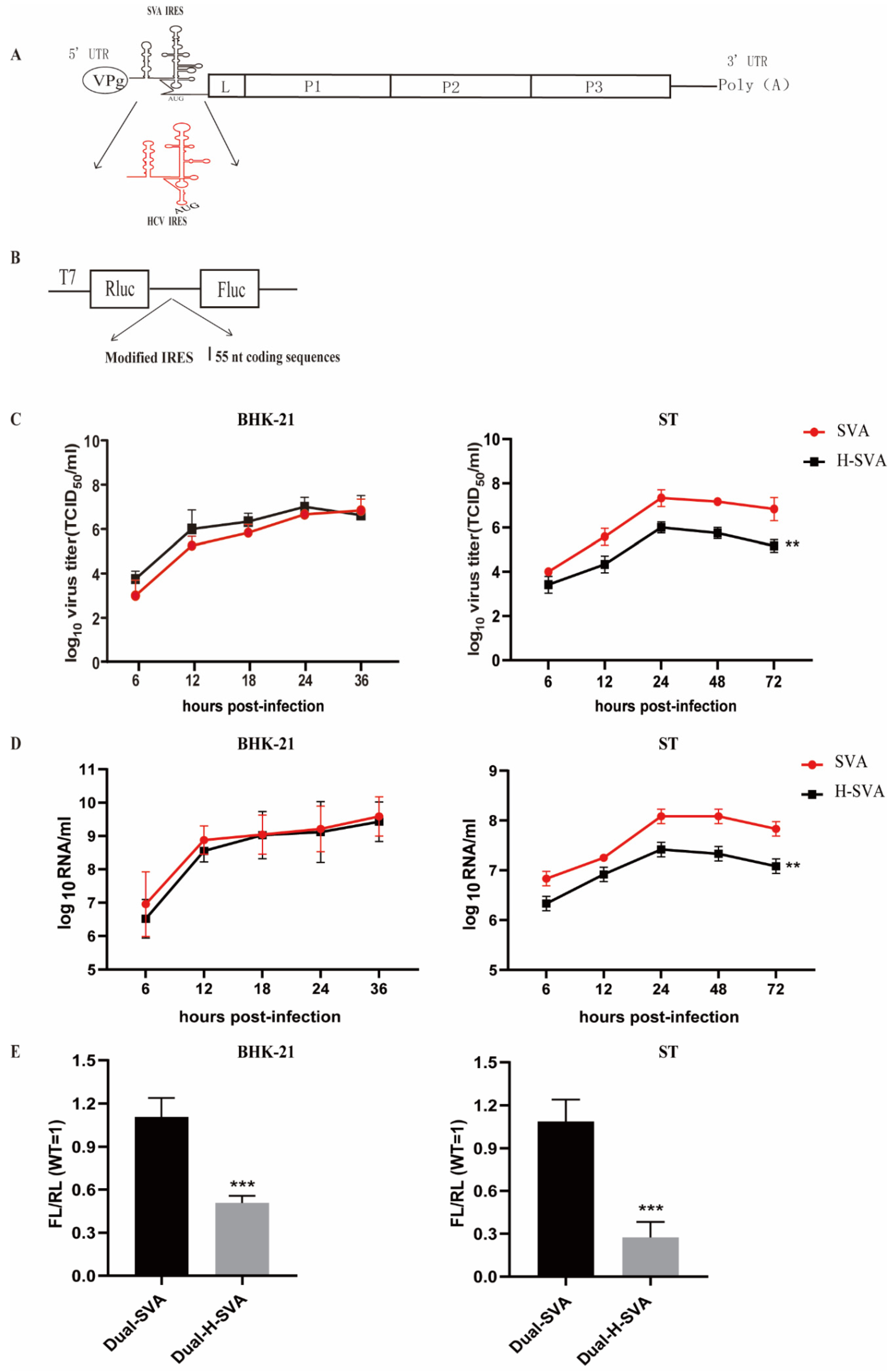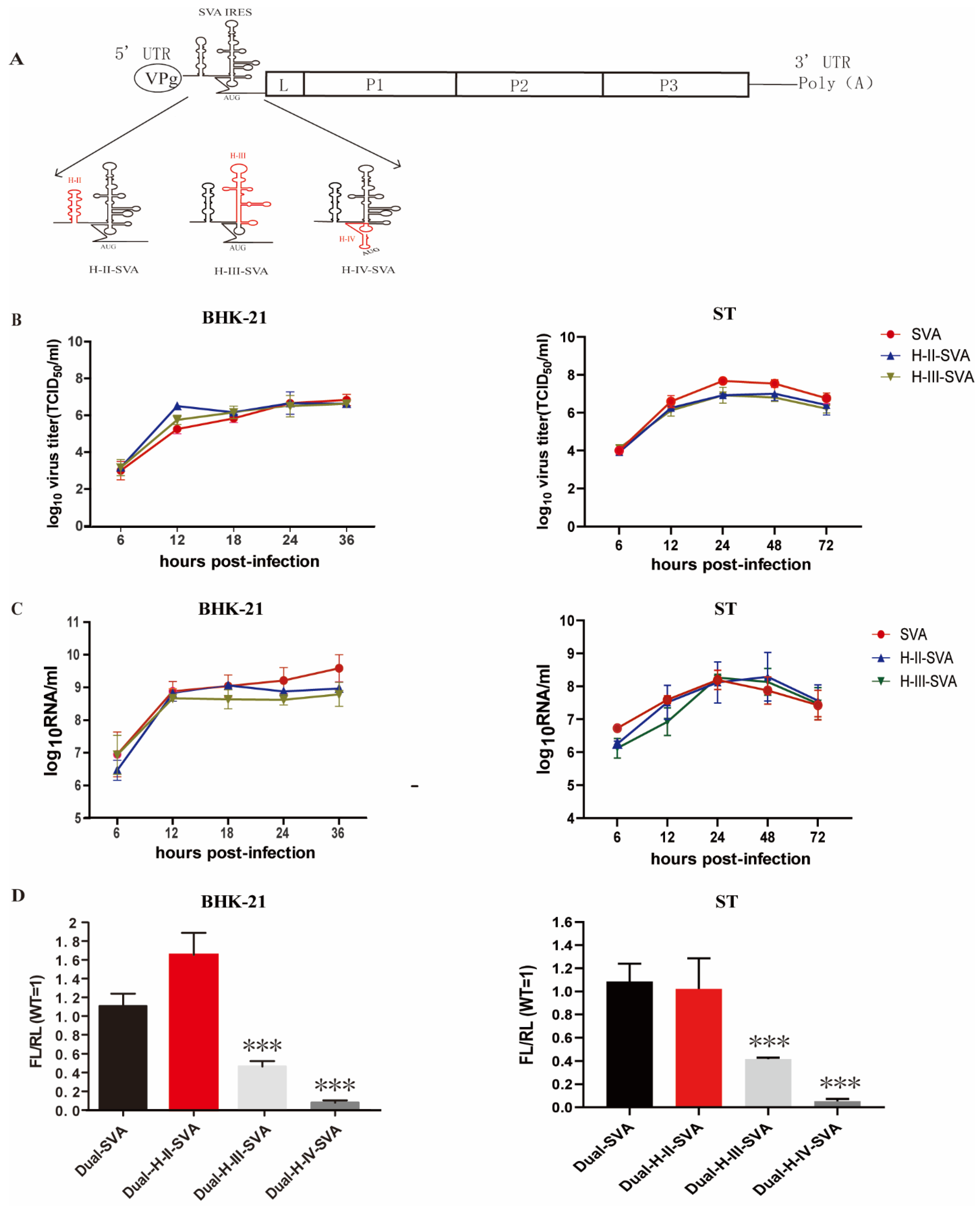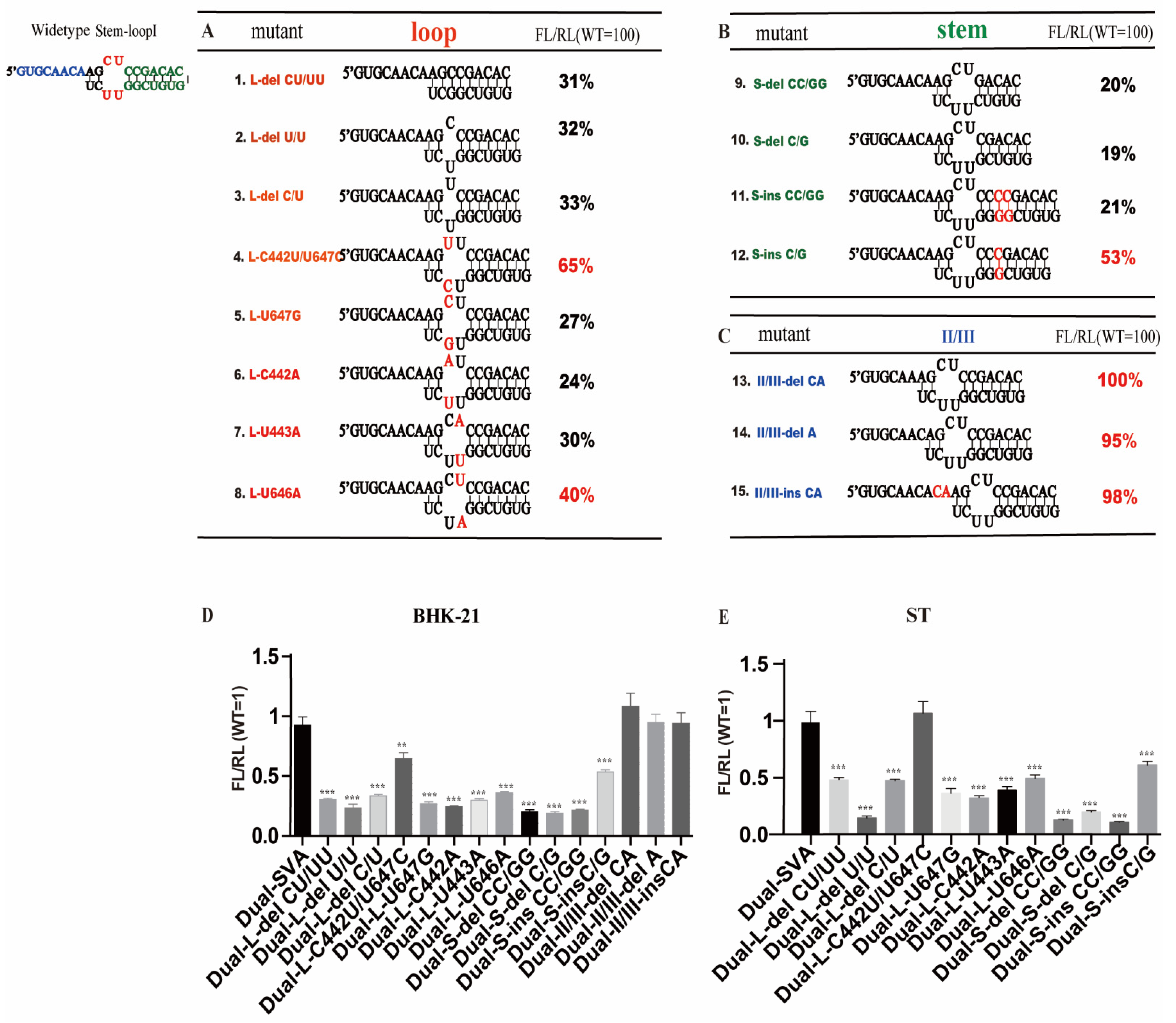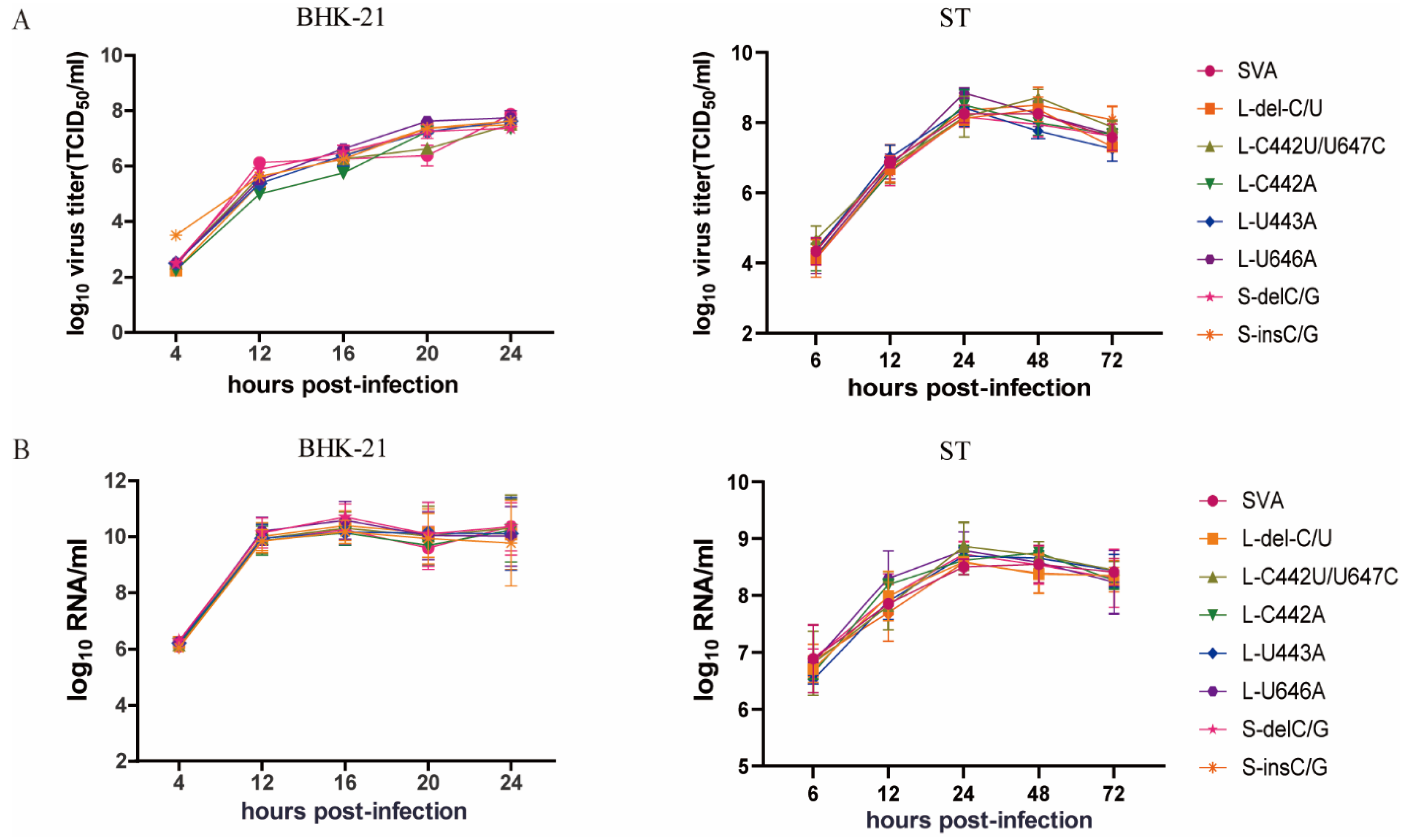The Stem-Loop I of Senecavirus A IRES Is Essential for Cap-Independent Translation Activity and Virus Recovery
Abstract
1. Introduction
2. Materials and Methods
2.1. Cells and Viruses
2.2. Construction of SVA/HCV IRES Chimeras
2.3. Construction of a Subgenomic Replicon Containing Dual-Luciferase Reporter Gene
2.4. Recovery of Recombinant Viruses
2.5. Luciferase Assay
2.6. TCID50 Assay and Growth Curve
2.7. RNA Extraction and Real-Time RT-qPCR
2.8. Statistical Analysis
3. Results
3.1. HCV IRES Replacement Conferred SVA Substantial Replicative Disadvantages in Porcine-Derived ST Cells
3.2. Domain IV Is Essential for the IRES Translation–Initiation Activity and Recovery of Viable Virus
3.3. The Stem-Loop I within Domain IV of SVA IRES Is Required for Recovery of Virus
3.4. Mutations in Stem-Loop I Affect the Translation Initiation Activity of IRES in Different Cell Lines
3.5. Mutations in Stem-Loop I Affect the Recovery of SVA In Vitro
4. Discussion
5. Conclusions
Author Contributions
Funding
Institutional Review Board Statement
Informed Consent Statement
Data Availability Statement
Acknowledgments
Conflicts of Interest
Abbreviations
References
- Segalés, J.; de Barcellos, D.E.S.N.; Alfieri, A.; Burrough, E.; Marthaler, D. Senecavirus A: An emerging pathogen causing vesicular disease and mortality in pigs? Vet. Pathol. 2017, 54, 11–21. [Google Scholar] [CrossRef] [PubMed]
- Liu, F.; Wang, Q.; Huang, Y.; Wang, N.; Shan, H. A 5-Year Review of Senecavirus A in China since Its Emergence in 2015. Front. Vet. Sci. 2020, 7, 567792. [Google Scholar] [CrossRef] [PubMed]
- Joshi, L.; Fernandes, M.H.V.; Clement, T.; Lawson, S.; Pillatzki, A.; Resende, T.P.; Vannucci, F.A.; Kutish, G.F.; Nelson, E.A.; Diel, D.G. Pathogenesis of Senecavirus A infection in finishing pigs. J. Gen. Virol. 2016, 97, 3267–3279. [Google Scholar] [CrossRef]
- Wu, Q.; Zhao, X.; Bai, Y.; Sun, B.; Xie, Q.; Ma, J. The First Identification and Complete Genome of Senecavirus A Affecting Pig with Idiopathic Vesicular Disease in China. Transbound. Emerg. Dis. 2016, 64, 1633–1640. [Google Scholar] [CrossRef] [PubMed]
- Guo, B.; Piñeyro, P.E.; Rademacher, C.J.; Zheng, Y.; Li, G.; Yuan, J.; Hoang, H.; Gauger, P.C.; Madson, D.M.; Schwartz, K.J.; et al. Novel Senecavirus A in Swine with Vesicular Disease, United States, July 2015. Emerg. Infect. Dis. 2016, 22, 1325–1327. [Google Scholar] [CrossRef] [PubMed]
- Leme, R.A.; Oliveira, T.E.; Alcântara, B.K.; Headley, S.A.; Alfieri, A.F.; Yang, M.; Alfieri, A.A. Clinical Manifestations of Senecavirus a Infection in Neonatal Pigs, Brazil, 2015. Emerg. Infect. Dis. 2016, 22, 1238–1241. [Google Scholar] [CrossRef]
- Jiang, J.; Zha, Y.; Liu, J.; Xing, C.; Mi, S.; Yu, J.; Sun, Y.; Tu, C.; Gong, W.; Lu, Z. Isolation and evolutionary analysis of Senecavirus A isolates from Guangdong province, China. Infect. Genet. Evol. 2021, 91, 104819. [Google Scholar] [CrossRef] [PubMed]
- Joshi, L.R.; Mohr, K.A.; Gava, D.; Kutish, G.; Buysse, A.S.; Vannucci, F.A.; Piñeyro, P.E.; Crossley, B.M.; Schiltz, J.J.; Jenkins-Moore, M.; et al. Genetic diversity and evolution of the emerging picornavirus Senecavirus A. J. Gen. Virol. 2020, 101, 175–187. [Google Scholar] [CrossRef] [PubMed]
- Fernández, N.; Buddrus, L.; Piñeiro, D.; Martínez-Salas, E. Evolutionary conserved motifs constrain the RNA structure organization of picornavirus IRES. FEBS Lett. 2013, 587, 1353–1358. [Google Scholar] [CrossRef]
- Yang, Y.; Wang, Z. IRES-mediated cap-independent translation, a path leading to hidden proteome. J. Mol. Cell Biol. 2019, 11, 911–919. [Google Scholar] [CrossRef]
- Lee, K.-M.; Chen, C.-J.; Shih, S.-R. Regulation Mechanisms of Viral IRES-Driven Translation. Trends Microbiol. 2017, 25, 546–561. [Google Scholar] [CrossRef]
- Martínez-Salas, E.; Francisco-Velilla, R.; Fernandez, J.; Lozano, G.; Diaz-Toledano, R. Picornavirus IRES elements: RNA structure and host protein interactions. Virus Res. 2015, 206, 62–73. [Google Scholar] [CrossRef]
- Leme, R.A.; Alfieri, A.F.; Alfieri, A.A. Update on Senecavirus Infection in Pigs. Viruses 2017, 9, 170. [Google Scholar] [CrossRef] [PubMed]
- Chard, L.; Bordeleau, M.-E.; Pelletier, J.; Tanaka, J.; Belsham, G.J. Hepatitis C virus-related internal ribosome entry sites are found in multiple genera of the family Picornaviridae. J. Gen. Virol. 2006, 87, 927–936. [Google Scholar] [CrossRef]
- Berry, K.E.; Waghray, S.; Doudna, J.A. The HCV IRES pseudoknot positions the initiation codon on the 40S ribosomal subunit. RNA 2010, 16, 1559–1569. [Google Scholar] [CrossRef]
- Kieft, J.S.; Zhou, K.; Jubin, R.; Doudna, J.A. Mechanism of ribosome recruitment by hepatitis C IRES RNA. RNA 2001, 7, 194–206. [Google Scholar] [CrossRef]
- Belsham, G.J. Divergent picornavirus IRES elements. Virus Res. 2009, 139, 183–192. [Google Scholar] [CrossRef] [PubMed]
- De Breyne, S.; Yu, Y.; Pestova, T.V.; Hellen, C.U. Factor requirements for translation initiation on the Simian picornavirus internal ribosomal entry site. RNA 2007, 14, 367–380. [Google Scholar] [CrossRef] [PubMed]
- Wang, H.; Li, C.; Zhao, B.; Yuan, T.; Yang, D.; Zhou, G.; Yu, L. Complete genome sequence and phylogenetic analysis of Senecavirus A isolated in Northeast China in 2016. Arch. Virol. 2017, 162, 3173–3176. [Google Scholar] [CrossRef] [PubMed]
- Hellen, C.U.; de Breyne, S. A Distinct Group of Hepacivirus/Pestivirus-Like Internal Ribosomal Entry Sites in Members of Diverse Picornavirus Genera: Evidence for Modular Exchange of Functional Noncoding Rna Elements by Recombination. J. Virol. 2007, 81, 5850–5863. [Google Scholar] [CrossRef]
- Friis, M.B.; Rasmussen, T.B.; Belsham, G. Modulation of Translation Initiation Efficiency in Classical Swine Fever Virus. J. Virol. 2012, 86, 8681–8692. [Google Scholar] [CrossRef]
- Willcocks, M.M.; Zaini, S.; Chamond, N.; Ulryck, N.; Allouche, D.; Rajagopalan, N.; Davids, N.A.; Fahnøe, U.; Hadsbjerg, J.; Rasmussen, T.B.; et al. Distinct Roles for the Iiid2 Sub-Domain in Pestivirus and Picornavirus Internal Ribosome Entry Sites. Nucleic Acids Res. 2017, 45, 13016–13028. [Google Scholar] [CrossRef]
- Kim, H.; Kim, K.; Kim, D.W.; Jung, H.D.; Cheong, H.M.; Kim, K.H.; Kim, D.S.; Kim, Y.J. Identification of Recombinant Human Rhinovirus a and C in Circulating Strains from Upper and Lower Respiratory Infections. PLoS ONE 2013, 8, e68081. [Google Scholar] [CrossRef]
- Sun, C.; Yang, D.; Gao, R.; Liang, T.; Wang, H.; Zhou, G.; Rongyuan, G. Modification of the internal ribosome entry site element impairs the growth of foot-and-mouth disease virus in porcine-derived cells. J. Gen. Virol. 2016, 97, 901–911. [Google Scholar] [CrossRef] [PubMed]
- Yang, D.; Sun, C.; Gao, R.; Wang, H.; Liu, W.; Yu, K.; Zhou, G.; Zhao, B.; Yu, L. A Temperature-Dependent Translation Defect Caused by Internal Ribosome Entry Site Mutation Attenuates Foot-and-Mouth Disease Virus: Implications for Rational Vaccine Design. J. Virol. 2020, 94, e00990-20. [Google Scholar] [CrossRef]
- Li, C.; Wang, H.; Shi, J.; Yang, D.; Zhou, G.; Chang, J.; Cameron, C.E.; Woodman, A.; Yu, L. Senecavirus-Specific Recombination Assays Reveal the Intimate Link between Polymerase Fidelity and RNA Recombination. J. Virol. 2019, 93, e00576-19. [Google Scholar] [CrossRef] [PubMed]
- Willcocks, M.M.; Locker, N.; Gomwalk, Z.; Royall, E.; Bakhshesh, M.; Belsham, G.J.; Idamakanti, N.; Burroughs, K.D.; Reddy, P.S.; Hallenbeck, P.L.; et al. Structural Features of the Seneca Valley Virus Internal Ribosome Entry Site (IRES) Element: A Picornavirus with a Pestivirus-Like IRES. J. Virol. 2011, 85, 4452–4461. [Google Scholar] [CrossRef]
- Marschalek, A.; Finke, S.; Schwemmle, M.; Mayer, D.; Heimrich, B.; Stitz, L.; Conzelmann, K.-K. Attenuation of Rabies Virus Replication and Virulence by Picornavirus Internal Ribosome Entry Site Elements. J. Virol. 2009, 83, 1911–1919. [Google Scholar] [CrossRef] [PubMed]
- Jang, S.K.; Pestova, T.V.; Hellen, C.U.; Witherell, G.W.; Wimmer, E. Cap-Independent Translation of Picornavirus Rnas: Structure and Function of the Internal Ribosomal Entry Site. Enzyme 1990, 44, 292–309. [Google Scholar] [CrossRef]
- Fletcher, S.P.; Jackson, R.J. Pestivirus Internal Ribosome Entry Site (IRES) Structure and Function: Elements in the 5′ Untranslated Region Important for IRES Function. J. Virol. 2002, 76, 5024–5033. [Google Scholar] [CrossRef]
- Wang, C.; Sarnow, P.; Siddiqui, A. A conserved helical element is essential for internal initiation of translation of hepatitis C virus RNA. J. Virol. 1994, 68, 7301–7307. [Google Scholar] [CrossRef] [PubMed]
- Bradrick, S.S.; Lieben, E.A.; Carden, B.M.; Romero, J.R. A Predicted Secondary Structural Domain within the Internal Ribosome Entry Site of Echovirus 12 Mediates a Cell-Type-Specific Block to Viral Replication. J. Virol. 2001, 75, 6472–6481. [Google Scholar] [CrossRef] [PubMed][Green Version]
- Gromeier, M.; Bossert, B.; Arita, M.; Nomoto, A.; Wimmer, E. Dual Stem Loops within the Poliovirus Internal Ribosomal Entry Site Control Neurovirulence. J. Virol. 1999, 73, 958–964. [Google Scholar] [CrossRef]
- Borman, A.; Howell, M.T.; Patton, J.G.; Jackson, R.J. The involvement of a spliceosome component in internal initiation of human rhinovirus RNA translation. J. Gen. Virol. 1993, 74, 1775–1788. [Google Scholar] [CrossRef] [PubMed]
- Meerovitch, K.; Svitkin, Y.V.; Lee, H.S.; Lejbkowicz, F.; Kenan, D.J.; Chan, E.K.; Agol, V.I.; Keene, J.D.; Sonenberg, N. La Autoantigen Enhances and Corrects Aberrant Translation of Poliovirus Rna in Reticulocyte Lysate. J. Virol. 1993, 67, 3798–3807. [Google Scholar] [CrossRef]
- Evans, D.M.A.; Dunn, G.; Minor, P.D.; Schild, G.C.; Cann, A.J.; Stanway, G.; Almond, J.W.; Currey, K.; Maizel, J.V. Increased neurovirulence associated with a single nucleotide change in a noncoding region of the Sabin type 3 poliovaccine genome. Nat. Cell Biol. 1985, 314, 548–550. [Google Scholar] [CrossRef]
- Avanzino, B.C.; Jue, H.; Miller, C.M.; Cheung, E.; Fuchs, G.; Fraser, C.S. Molecular mechanism of poliovirus Sabin vaccine strain attenuation. J. Biol. Chem. 2018, 293, 15471–15482. [Google Scholar] [CrossRef]
- Liu, F.; Wang, N.; Wang, Q.; Shan, H. Motif mutations in pseudoknot stem I upstream of start codon in Senecavirus A genome: Impacts on activity of viral IRES and on rescue of recombinant virus. Vet. Microbiol. 2021, 262, 109223. [Google Scholar] [CrossRef] [PubMed]
- Kok, C.C.; Phuektes, P.; Bek, E.; McMINN, P.C. Modification of the Untranslated Regions of Human Enterovirus 71 Impairs Growth in a Cell-Specific Manner. J. Virol. 2011, 86, 542–552. [Google Scholar] [CrossRef]
- García-Nuñez, S.; Gismondi, M.I.; König, G.; Berinstein, A.; Taboga, O.; Rieder, E.; Martínez-Salas, E.; Carrillo, E. Enhanced IRES Activity by the 3′ UTR Element Determines the Virulence of FMDV Isolates. Virology 2014, 448, 303–313. [Google Scholar] [CrossRef] [PubMed][Green Version]
- Serrano, P.; Pulido, M.R.; Sáiz, M.; Martínez-Salas, E. The 3′ End of the Foot-and-Mouth Disease Virus Genome Establishes Two Distinct Long-Range RNA-RNA Interactions with the 5′ End Region. J. Gen. Virol. 2006, 87 Pt 10, 3013–3022. [Google Scholar] [CrossRef]





| # | Primer | Sequence(5′-3′) |
|---|---|---|
| 1 | NheI-F | GCT AGC ACT AGT TAA TAC GAC TCA CTA TAG GGT GTT AAG CG |
| 2 | SacII-R | AGT GTT TGC GTA GTA ATT GAA GGT CAT GTT ACC ATT ATT G |
| 3 | SacII-S1-R | TAA GTG TTT GCG TAG TAA TTG AAG GTC ATG TTA CCA TTA TTG |
| 4 | H-SVA-S-R | AGT AGT TCC TCA CAG GTC GCA GCC TTA AAA GGG ACT AAC AGC ATG TGG |
| 5 | H-SVA-H-F | CCT TTT AAG GCT GCG ACC TGT GAG GAA CTA CTG TCT TCA CGC AGA AAG |
| 6 | H-SVA-H-R | AAT GAG AGT TCT GCA TGG TGC ACG GTC TAC GAG ACC TCC CG |
| 7 | H-SVA-S-F | GTA GAC CGT GCA CCA TGC AGA ACT CTC ATT TTT CTT TCG ATA CAG CCT TG G |
| 8 | H-II-SVA-R | GAC TCT GTG TCG GAG CTT GTT GCA ACT GGA GGC TGC ACG ACA CTC ATA CTA ACG CCA TG |
| 9 | H-II-SVA-F | AGT GTC GTG CAG CCT CCA GTT GCA ACA AGC TCC GAC ACA GAG TCC ACG TGA TTG CTA CC |
| 10 | H-III-SVA-S-R | GGT TCC GCA GAC CAC TAT GGC TCT GTG TCG GAG CTT GTT GCA AGA AGG CCT CTC GGT TC |
| 11 | H-III-SVA-H-F | GGC CTT CTT GCA ACA AGC TCC GAC ACA GAG CCA TAG TGG TCT GCG GAA CCG GTG AGT AC |
| 12 | H-III-SVA-H-R | CCG ACA CGA CTA GGC CGT CAC CCT ATC AGG CAG TAC CAC AAG GCC TTT CGC GAC CCA AC |
| 13 | H-III-SVA-S-F | TGT GGT ACT GCC TGA TAG GGT GAC GGC CTA GTC GTG TCG GTT CTA TAG GTA GCA CAT AC |
| 14 | H-IV-SVA-R | CTC CCG GGG CAC TCG CAA GCG CCC TAT CAG GCA GTA TCC AAG GCA CGC TAA GGC CTA GC |
| 15 | H-IV-SVA-F | TAC TGC CTG ATA GGG CGC TTG CGA GTG CCC CGG GAG GTC TCG TAG ACC GTG CAC CAT GC |
| 16 | L-delCU/UU-ΔCU-R | GTA GCA ATC ACG TGG ACT CTG TGT CGG CTT GTT GCA AGA AGG CCT CTC GG |
| 17 | L-delCU/UU-ΔCU-F | CCG AGA GGC CTT CTT GCA ACA AGC CGA CACAGA GTC CAC GTG ATT GCT AC |
| 18 | L-delCU/UU-ΔUU-R | ATA TTT GTA TGT GCT ACC TAT AGC CGA CAC GAC TAG GCC GTC GCC CTA TC |
| 19 | L-delCU/UU-ΔUU-F | ATA GGG CGA CGG CCT AGT CGT GTC GGC TAT AGG TAG CAC ATA CAA ATA TG |
| 20 | L-delU/U-ΔU1-R | TAG CAA TCA CGT GGA CTC TGT GTC GGG CTT GTT GCA AGA AGG CCT CTC GG |
| 21 | L-delU/U-ΔU1-F | CGA GAG GCC TTC TTG CAA CAA GCC CGA CACAGA GTC CAC GTG ATT GCT AC |
| 22 | L-delU/U-ΔU2-R | TAT TTG TAT GTG CTA CCT ATA GAC CGA CAC GAC TAG GCC GTC GCC CTA TC |
| 23 | L-delU/U-ΔU2-F | TAG GGC GAC GGC CTA GTC GTG TCG GTC TAT AGG TAG CAC ATA CAA ATA TG |
| 24 | L-C442U/U647C-C442U-R | AGC AAT CAC GTG GAC TCT GTG TCG GAA CTT GTT GCA AGA AGG CCT CTC GG |
| 25 | L-C442U/U647C-C442U-F | GAG AGG CCT TCT TGC AAC AAG TTC CGA CACAGA GTC CAC GTG ATT GCT AC |
| 26 | L-C442U/U647C-U647C-R | GCA TAT TTG TAT GTG CTA CCT ATA GGA CCG ACA CGA CTA GGC CGT CGC CCT ATC |
| 27 | L-C442U/U647C-U647C-F | TAG GGC GAC GGC CTA GTC GTG TCG GTC CTA TAG GTA GCA CAT ACA AAT ATG CAG |
| 28 | L-U647G-R | AGC AAT CAC GTG GAC TCT GTG TCG GAT CTT GTT GCA AGA AGG CCT CTC GG |
| 29 | L-U647G-F | AGA GGC CTT CTT GCA ACA AGA TCC GAC ACA GAG TCC ACG TGA TTG CTA CC |
| 30 | L-C442A-R | AGC AAT CAC GTG GAC TCT GTG TCG GAT CTT GTT GCA AGA AGG CCT CTC GG |
| 31 | L-C442A-F | AGA GGC CTT CTT GCA ACA AGA TCC GAC ACA GAG TCC ACG TGA TTG CTA CC |
| 32 | L-U443A-R | AGC AAT CAC GTG GAC TCT GTG TCG GTG CTT GTT GCA AGA AGG CCT CTC GG |
| 33 | L-U443A-F | ACC GAG AGG CCT TCT TGC AAC AAG CAC CGACAC AGA GTC CAC GTG ATT GCT ACC |
| 34 | L-U646A-R | ATT TGT ATG TGC TAC CTA TAG ATC CGA CAC GAC TAG GCC GTC GCC CTA TC |
| 35 | L-U646A-F | GGG CGA CGG CCT AGT CGT GTC GGA TCT ATA GGT AGC ACA TAC AAA TAT GC |
| 36 | S-delCC/GG-ΔCC-R | GTA GCA ATC ACG TGG ACT CTG TGT CAG CTT GTT GCA AGA AGG CCT CTC GG |
| 37 | S-delCC/GG-ΔCC-F | CCG AGA GGC CTT CTT GCA ACA AGC TGA CAC AGA GTC CAC GTG ATT GCT AC |
| 38 | S-delCC/GG-ΔGG-R | GCA TAT TTG TAT GTG CTA CCT ATA GAA GAC ACG ACT AGG CCG TCG CCC TAT CAG |
| 39 | S-delCC/GG-ΔGG-F | CTG ATA GGG CGA CGG CCT AGT CGT GTC TTC TAT AGG TAG CAC ATA CAA ATA TGC |
| 40 | S-delC/G-ΔC-R | CAA TCA CGT GGA CTC TGT GTC GAG CTT GTT GCA AGA AGG CCT CTC GGT TC |
| 41 | S-delC/G-ΔC-F | CGA GAG GCC TTC TTG CAA CAA GCT CGA CAC AGA GTC CAC GTG ATT GCT ACC ACC |
| 42 | S-delC/G-ΔG-R | TAT TTG TAT GTG CTA CCT ATA GAA CGA CAC GAC TAG GCC GTC GCC CTA TC |
| 43 | S-delC/G-ΔG-F | TGA TAG GGC GAC GGC CTA GTC GTG TCG TTC TAT AGG TAG CAC ATA CAA ATA TGC |
| 44 | S-insCC/GG-insCC-R | GTA GCA ATC ACG TGG ACT CTG TGT CGG GGA GCT TGT TGC AAG AAG GCC TCT CGG |
| 45 | S-insCC/GG-insCC-F | CCG AGA GGC CTT CTT GCA ACA AGC TCC CCG ACA CAG AGT CCA CGT GAT TGC TAC |
| 46 | S-insCC/GG-insGG-R | ATA TTT GTA TGT GCT ACC TAT AGA ACC CCG ACA CGA CTA GGC CGT CGC CCT ATC |
| 47 | S-insCC/GG-insGG-F | ATA GGG CGA CGG CCT AGT CGT GTC GGG GTT CTA TAG GTA GCA CAT ACA AAT ATG |
| 48 | S-insC/G-insC-R | GTG GTA GCA ATC ACG TGG ACT CTG TGT CGG GAG CTT GTT GCA AGA AGG CCT CTC |
| 49 | S-insC/G-insC-F | AGA GGC CTT CTT GCA ACA AGC TCC CGA CAC AGA GTC CAC GTG ATT GCT ACC ACC |
| 50 | S-insC/G-insG-R | TAT TTG TAT GTG CTA CCT ATA GAA CCC GAC ACG ACT AGG CCG TCG CCC TAT CAG |
| 51 | S-insC/G-insG-F | GAT AGG GCG ACG GCC TAG TCG TGT CGG GTT CTA TAG GTA GCA CAT ACA AAT ATG |
| 52 | II/III-delCA-R | ATC ACG TGG ACT CTG TGT CGG AGC TGT TGC AAG AAG GCC TCT CGG TTC CC |
| 53 | II/III-delCA-F | CTT AGT AAG GGA ACC GAG AGG CCT TCT TGCAAC AGC TCC GAC ACA GAG TCC ACG |
| 54 | II/III-delA-R | AAT CAC GTG GAC TCT GTG TCG GAG CTT TGC AAG AAG GCC TCT CGG TTC CCT TAC |
| 55 | II/III-delA-F | TAA GGG AAC CGA GAG GCC TTC TTG CAA AGCTCC GAC ACA GAG TCC ACG TGA TTG |
| 56 | II/III-insCA-R | GTG GAC TCT GTG TCG GAG CTT GTG TTG CAA GAA GGC CTC TCG GTT CCC TTA C |
| 57 | II/III-insCA-F | AGT AAG GGA ACC GAG AGG CCT TCT TGC AACACA AGC TCC GAC ACA GAG TCC ACG |
| # | Primer | Sequence (5′-3′) |
|---|---|---|
| 1 | Dual-SVA-B/N-F | GCC GTG TAA GAA TTC GAA GAT CTG ATG GCT ATC CAC |
| 2 | Dual-B/N-R | CGA AGT CAT GGA TCC CAT GGC ATG GTT ACG TCT |
| 3 | Dual-HCV-B/N-F | CCC GGG CTC GAG ATC TCC TGT GAG GAA CTA CTG TC |
Publisher’s Note: MDPI stays neutral with regard to jurisdictional claims in published maps and institutional affiliations. |
© 2021 by the authors. Licensee MDPI, Basel, Switzerland. This article is an open access article distributed under the terms and conditions of the Creative Commons Attribution (CC BY) license (https://creativecommons.org/licenses/by/4.0/).
Share and Cite
Wang, N.; Wang, H.; Shi, J.; Li, C.; Liu, X.; Fan, J.; Sun, C.; Cameron, C.E.; Qi, H.; Yu, L. The Stem-Loop I of Senecavirus A IRES Is Essential for Cap-Independent Translation Activity and Virus Recovery. Viruses 2021, 13, 2159. https://doi.org/10.3390/v13112159
Wang N, Wang H, Shi J, Li C, Liu X, Fan J, Sun C, Cameron CE, Qi H, Yu L. The Stem-Loop I of Senecavirus A IRES Is Essential for Cap-Independent Translation Activity and Virus Recovery. Viruses. 2021; 13(11):2159. https://doi.org/10.3390/v13112159
Chicago/Turabian StyleWang, Nana, Haiwei Wang, Jiabao Shi, Chen Li, Xinran Liu, Junhao Fan, Chao Sun, Craig E. Cameron, Hong Qi, and Li Yu. 2021. "The Stem-Loop I of Senecavirus A IRES Is Essential for Cap-Independent Translation Activity and Virus Recovery" Viruses 13, no. 11: 2159. https://doi.org/10.3390/v13112159
APA StyleWang, N., Wang, H., Shi, J., Li, C., Liu, X., Fan, J., Sun, C., Cameron, C. E., Qi, H., & Yu, L. (2021). The Stem-Loop I of Senecavirus A IRES Is Essential for Cap-Independent Translation Activity and Virus Recovery. Viruses, 13(11), 2159. https://doi.org/10.3390/v13112159







